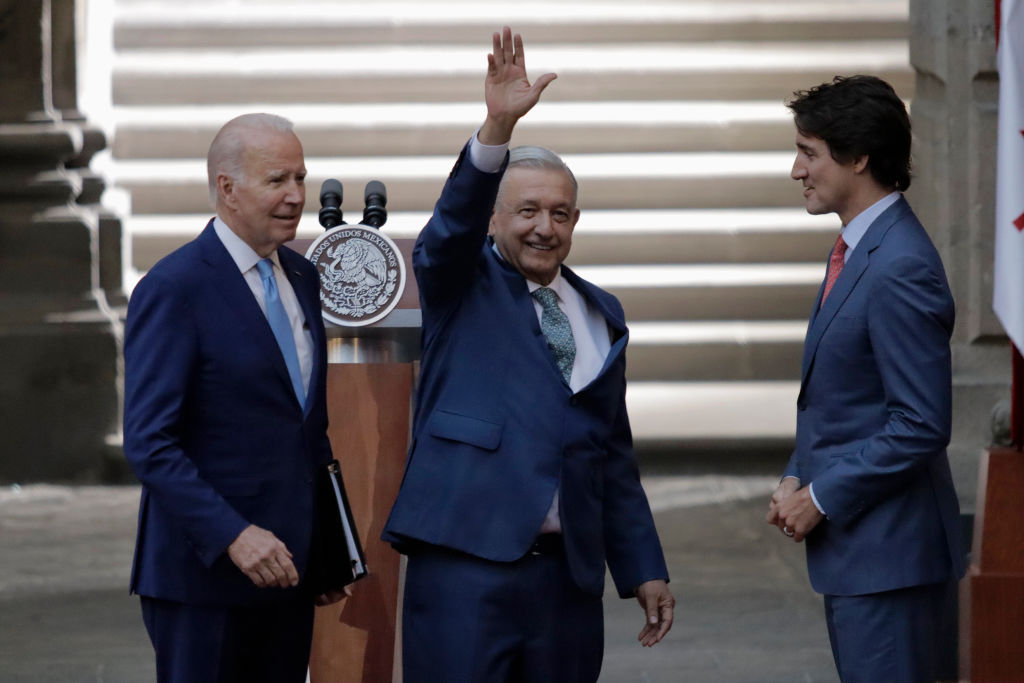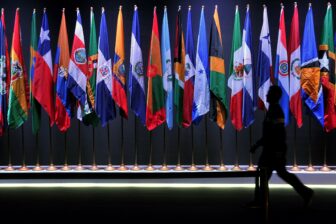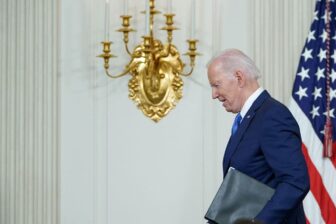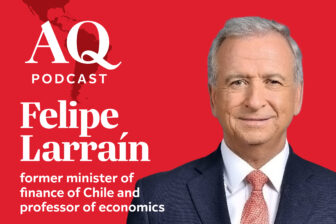For the tenth time since 2005, another North American Leaders’ Summit has come and gone and, with it, questions about how much progress was made on goals set at the last one. U.S. President Joe Biden and Canadian Prime Minister Justin Trudeau bid adiós to their host and Mexican counterpart Andrés Manuel López Obrador with a freshly inked trilateral declaration in hand, spurring questions about whether the three governments can make good on new pledges by the next Summit. Pundits will point out which lofty goals were raised (climate change, migration, supply chains) and which ones took a backseat (U.S.-Canadian concerns over Mexico’s statist energy policy).
As is often the case with global summits, events surrounding the leaders’ January 9–10 head-to-head in Mexico City drew as many headlines as the forum itself. Biden, under pressure to address record-breaking migrant apprehensions at the U.S.-Mexico border, made a stop in the border region for the first time as president on his way to Mexico after announcing new immigration measures that simultaneously limit and create new paths for migration from Cuba, Haiti, Nicaragua and Venezuela. On top of that, three years after they let him go free, Mexican authorities arrested the Sinaloa Cartel’s Ovidio Guzmán, son of infamous cartel leader Joaquín “El Chapo” Guzmán, three days ahead of Biden’s arrival. The arrest, which sparked gun battles and lockdowns, took place after the DEA released stark figures saying it had seized enough lethal fentanyl doses in 2022 to “kill every American” while identifying the Sinaloa Cartel as a number one target in its battle against the synthetic opioid. In Mexico, meanwhile, much was made of the fact that Biden had switched his arrival to a newly renovated airport seen as a cornerstone project of the López Obrador government but frequently lambasted by critics for lackluster transportation options and a dearth of flights.
But one moment from the meetings did raise many an eyebrow. “The time has come to end [U.S.] forgetfulness, abandonment, and disdain toward Latin America and the Caribbean,” López Obrador, often called AMLO, told Biden ahead of the two leaders’ January 9 meeting.
Some would say he has a point. After all, recent years have left Washington reeling from democratic erosion and pandemic repercussions at home while it is forced to look over its shoulder at Russia and China. As those woes demanded U.S. attention, Latin America witnessed its own turbulence, from largescale protests beginning with Chile’s in 2019 to a presidential assassination to a nearly region-wide anti-incumbent electoral wave that showcases a frustration with the political status quo.
In fact, on the same day Air Force One touched down in Mexico, shocking images showed supporters of ex-President Jair Bolsonaro storming government buildings in Brasília in an all too familiar demonstration of the damage wrought by political polarization. News out of Brazil even threatened to upstage the trilateral meeting, with the three governments issuing a joint statement in support of recently inaugurated Brazilian President Luiz Inácio Lula da Silva as the Summit got underway.
But others might caution AMLO about throwing stones in glass houses. The president, known for saying, “The best foreign policy is good domestic policy,” rarely travels beyond Mexico’s borders, sending his foreign minister to represent the country in his stead at global forums. AMLO even skipped the June 2022 Summit of the Americas, which the Biden administration held a short flight away in Los Angeles. While he questionably argued that leaders from undemocratic regimes Cuba, Nicaragua and Venezuela should have been invited to California, the truth is that AMLO is more comfortable at home, where he can take center stage, much as he did when he delivered a 28-minute monologue during his January 10 press conference with Biden and Trudeau.
When making his January 9 comments suggesting U.S. neglect of the region, AMLO, who has a penchant for invoking historical figures, raised John F. Kennedy’s Alliance for Progress and said that the U.S. at the time invested the equivalent of what would now be $82 billion in Latin America. In response, Biden reminded the Mexican leader that Washington already provides more foreign aid than any other country in the world and that, “Unfortunately, our responsibility doesn’t end in the Western Hemisphere.”
Beyond Washington’s global obligations, the Biden administration finds itself treading a fine line between getting criticized for not paying enough attention to the region and running the risk of standing accused of intervening in Latin American affairs. It’s highly unlikely, for example, that AMLO would welcome Washington taking action against his own government’s controversial legal moves to weaken Mexico’s autonomous electoral agency, known as the INE. The issue was not raised publicly during the Summit.
Instead, the word “partner” came up multiple times over the course of the North American Leaders’ Summit, bringing to mind a speech Joe Biden delivered to the Council of the Americas as vice president in 2013 where he said: “It’s no longer what we can do for [Latin America], it’s what we can do with [Latin America].”
Through that lens, the three governments—which under USMCA have deeply integrated supply chains allowing for $1.5 trillion in annual trilateral trade—mapped out areas for North American collaboration that they can keep hammering away at on a ministerial level and in other meetings before the eleventh Summit takes place in Canada.
In Mexico, they committed to efforts such as holding a semiconductor forum in partnership with the private sector and critical minerals resource mapping to expand production of electric vehicles. Ahead of the meeting, there were already signs of how regional cooperation is paying off; Mexico saw FDI rise 30% in the first three quarters of 2022, with the United States and Canada its two biggest FDI sources and more than a third of FDI destined for the manufacturing sector. Even as AMLO called for more U.S. attention in the region—and with “nearshoring” the current buzzword—he suggested that the Americas offer a competitive advantage to Asia, from geographical proximity to the region’s relatively young workforce.
Already, the Summit is wrapped, the media blitz focusing on the trilateral relationship is petering out, and the heads of state will turn to other issues popping up in the news cycle. Eventually, a new North American Leaders’ Summit will be held and, despite the hugs and handshakes of recent days, many will look for the fissures in what has become known as the “Three Amigos Summit.” Once again, observers will check the 2023 task list and question whether enough got done. The answer will, again, most likely be “no.” But these three countries will have made more progress by coming together to focus attention on goals they can work on.
—
Zissis is editor-in-chief of AS/COA Online








